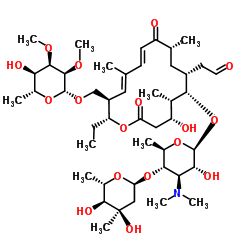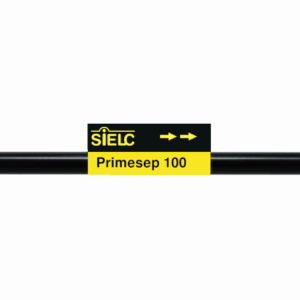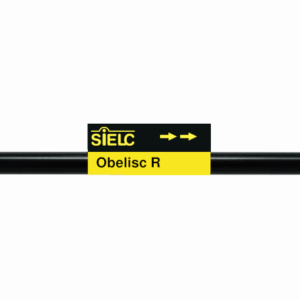| CAS Number | 1401-69-0 |
|---|---|
| Molecular Formula | C46H77NO17 |
| Molecular Weight | 916.112 |
| InChI Key | WBPYTXDJUQJLPQ-SZRMRBKTSA-N |
| LogP | 1.63 |
| Synonyms |
|
Applications:
HPLC Method for Analysis of Tylosin A, B, C, D on Primesep 100 Column
October 2, 2025
HPLC Method for Tylosin on Primesep 100 by SIELC Technologies
High Performance Liquid Chromatography (HPLC) Method for Analysis of Tylosin
Tylosin A (C46H77NO17), Tylosin B (C39H65NO14), Tylosin C (C45H75NO17), and Tylosin D (C46H79NO17) are antibiotics that are typically used to treat infections and inflammations, especially in veterinary cases.
Tylosin can be retained and analyzed using the Primesep 100 stationary phase column. The analysis utilizes a gradient method with a simple mobile phase consisting of water and acetonitrile (MeCN) with a sulfuric acid buffer. Detection is performed using ELSD.
*LOD was determined for this combination of instrument, method, and analyte, and it can vary from one laboratory to another even when the same general type of analysis is being performed.
| Column | Primesep 100, 4.6 x 150 mm, 5 µm, 100 A, dual ended |
| Mobile Phase | Gradient MeCN/H2O from 10/90% to 60/40% 30 min |
| Buffer | Ammonium Formate pH 3.0 – 60 mM |
| Flow Rate | 1.0 ml/min |
| Detection | UV 286 |
| Class of Compounds | Antibiotic |
| Analyzing Compounds | Tylosin |
Application Column
Primesep 100
Column Diameter: 4.6 mm
Column Length: 150 mm
Particle Size: 5 µm
Pore Size: 100 A
Column options: dual ended

UV-Vis Spectrum of Tylosin
September 25, 2025
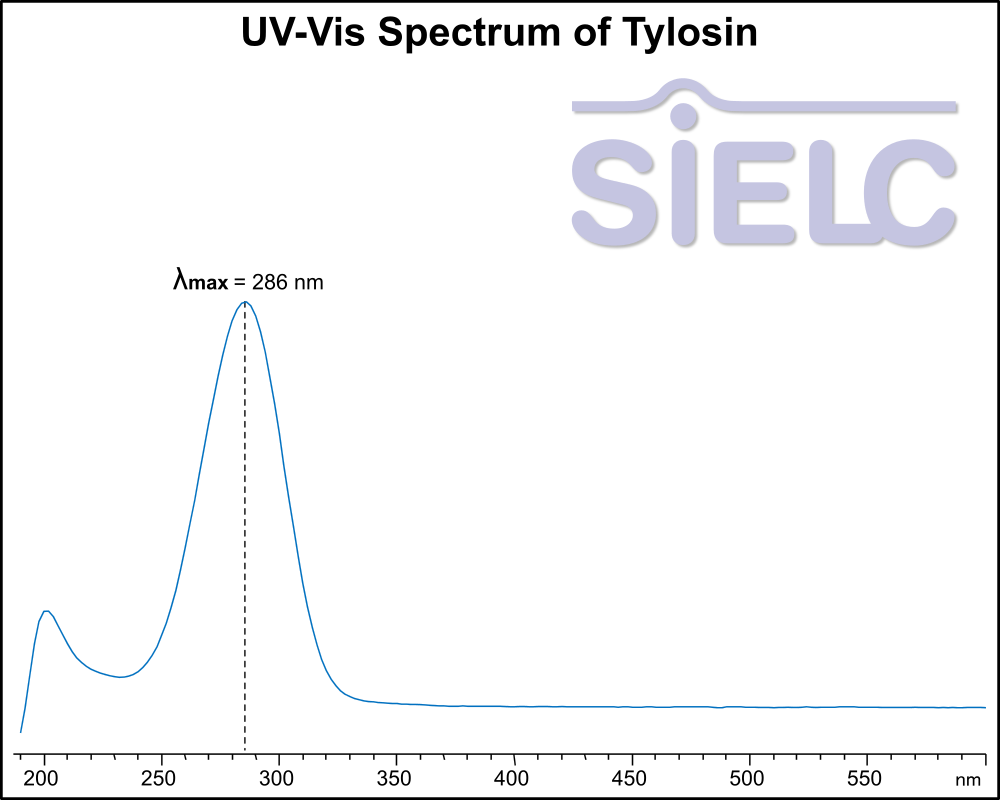
For optimal results in HPLC analysis, it is recommended to measure absorbance at a wavelength that matches the absorption maximum of the compound(s) being analyzed. The UV spectrum shown can assist in selecting an appropriate wavelength for your analysis. Please note that certain mobile phases and buffers may block wavelengths below 230 nm, rendering absorbance measurement at these wavelengths ineffective. If detection below 230 nm is required, it is recommended to use acetonitrile and water as low UV-transparent mobile phases, with phosphoric acid and its salts, sulfuric acid, and TFA as buffers.
For some compounds, the UV-Vis Spectrum is affected by the pH of the mobile phase. The spectra presented here are measured with an acidic mobile phase that has a pH of 3 or lower.

HPLC Method for Analysis of Tylosin on Primesep 100 Column
September 25, 2025
HPLC Method for Tylosin on Primesep 100 by SIELC Technologies
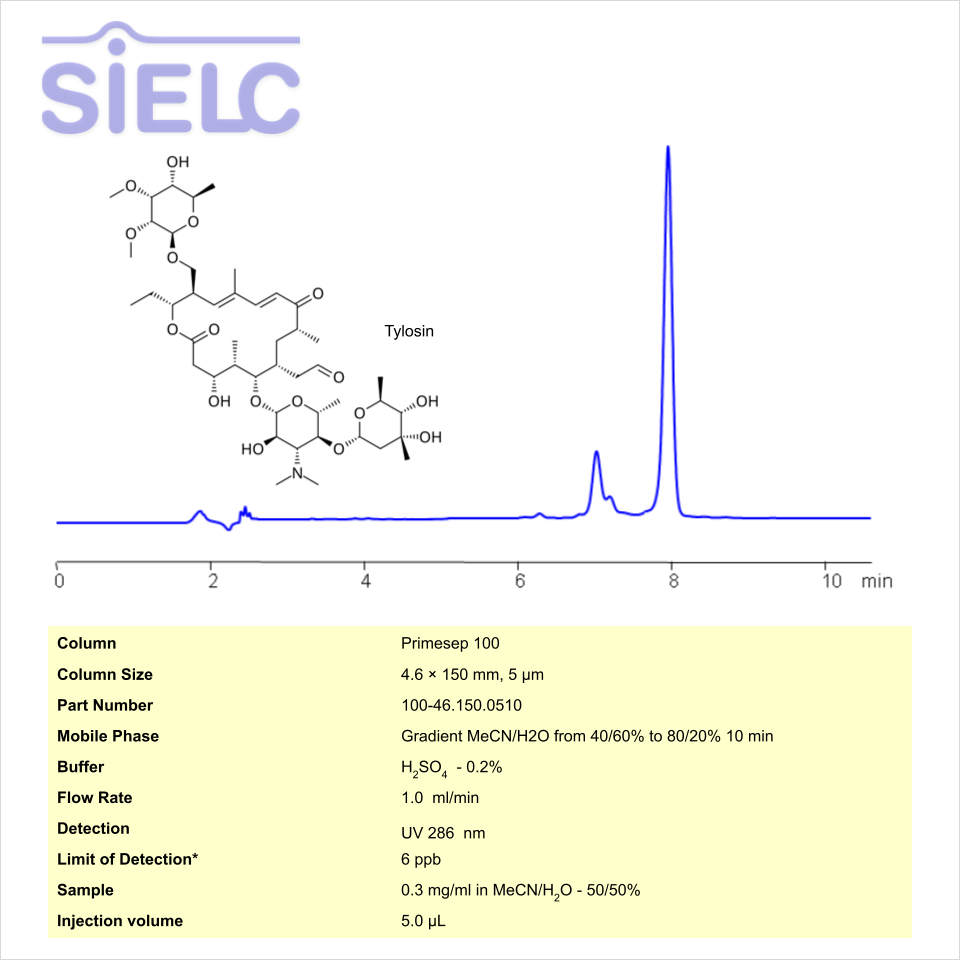
High Performance Liquid Chromatography (HPLC) Method for Analysis of Tylosin
Tylosin is an antibiotic with the molecular formula C46H77NO17. It is typically used to treat infections and inflammations, especially in veterinary cases. It can be administered orally as a powder or liquid or through injection.
Tylosin can be retained and analyzed using the Primesep 100 stationary phase column. The analysis utilizes a gradient method with a simple mobile phase consisting of water and acetonitrile (MeCN) with a sulfuric acid buffer. Detection is performed using ELSD.
*LOD was determined for this combination of instrument, method, and analyte, and it can vary from one laboratory to another even when the same general type of analysis is being performed.
| Column | Primesep 100, 4.6 x 150 mm, 5 µm, 100 A, dual ended |
| Mobile Phase | Gradient MeCN/H2O from 40/60% to 80/20% 10 min |
| Buffer | H2SO4 – 0.2% |
| Flow Rate | 1.0 ml/min |
| Detection | UV 286 |
| Class of Compounds | Antibiotic |
| Analyzing Compounds | Tylosin |
Application Column
Primesep 100
Column Diameter: 4.6 mm
Column Length: 150 mm
Particle Size: 5 µm
Pore Size: 100 A
Column options: dual ended

Analysis of Antibiotic Tylosin and Related Impurities in Mixed-Mode Chromatography
May 12, 2015
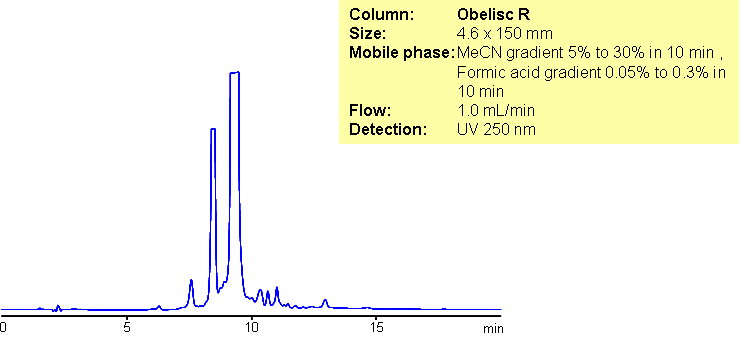
Tylosin is a macrolide antibiotic with a broad spectrum of activity against gram-negative and gram-positive organisms. It is highly polar and basic molecule with limited retention in reversed-phase chromatography. Tylosin and related impurities were analysed on Obelisc R trimodal column. Method is compatible with LC/MS and prep chromatography and can be used for HPLC analysis of tylosin in various biofluids.
| Column | Obelisc R, 2.1×150 mm, 5 µm, 100A |
| Mobile Phase | Gradient MeCN – 5-30%, 10 min, 5 min hold |
| Buffer | Gradient Formic Acid – 0.05%-0.3%, 10 min, 5 min hold |
| Flow Rate | 1.0 ml/min |
| Detection | UV, 250 nm |
| Class of Compounds |
Insecticide, Herbicide, Fungicide, Hydrophobic, Ionizable |
| Analyzing Compounds | Tylosin |
Application Column
Obelisc R
SIELC has developed the Obelisc™ columns, which are mixed-mode and utilize Liquid Separation Cell technology (LiSC™). These cost-effective columns are the first of their kind to be commercially available and can replace multiple HPLC columns, including reversed-phase (RP), AQ-type reversed-phase, polar-embedded group RP columns, normal-phase, cation-exchange, anion-exchange, ion-exclusion, and HILIC (Hydrophilic Interaction Liquid Chromatography) columns. By controlling just three orthogonal method parameters - buffer concentration, buffer pH, and organic modifier concentration - users can adjust the column properties with pinpoint precision to separate complex mixtures.
Select optionsUV Detection

Separation of Antibiotics in Mixed-mode chromatography
May 11, 2015
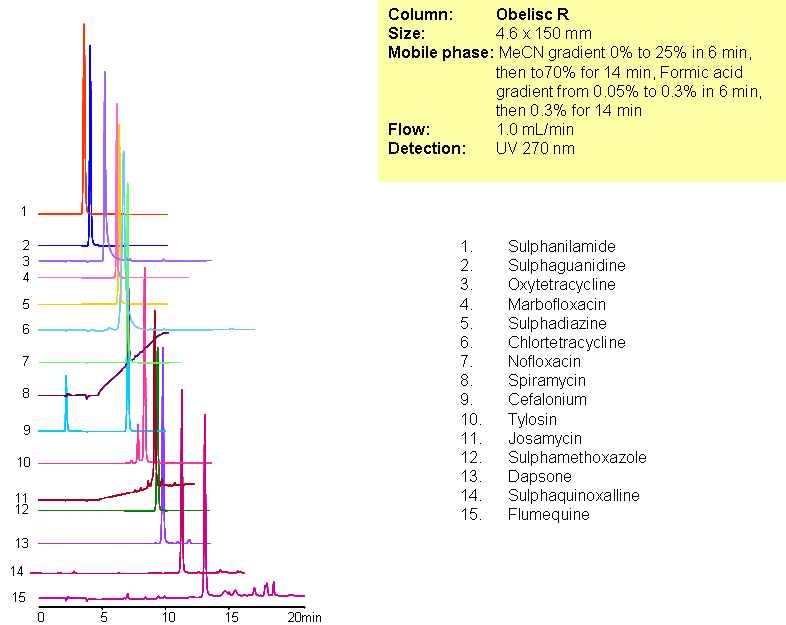
A complex mixture of sulphonamide, macrolide, tetracycline and fluoroquinolone antibiotics were separated in one run using mixed-mode chromatography with LC/MS -compatible conditions. All compounds are separated based on reversed-phase and/or ion-exchange mechanism. Method can be used for analysis of various classes of antibiotics and related impurities in different sample matrices (blood, urine, soil, waste water).
| Column | Obelisc R, 2.1×150 mm, 5 µm, 100A |
| Mobile Phase | Gradient MeCN – 0-25%, 6 min, 25-70% 14 min |
| Buffer | Gradient Formic Acid – 0.05%-0.3%, 10 min, 14 min hold |
| Flow Rate | 1.0 ml/min |
| Detection | UV, 270 nm |
| Class of Compounds |
Antibiotic, Drug, Hydrophobic, Ionizable |
| Analyzing Compounds | Sulphanilamide, Sulphaguanidine, Oxytetracycline, Marbofloxacin, Sulphadiazine, Chlortetracycline, Nofloxacin, Spiramycin, Cefalonium, Tylosin, Josamycin, Sulphamethoxazole, Dapsone, Sulphaquinoxalline, Flumequine |
Application Column
Obelisc R
SIELC has developed the Obelisc™ columns, which are mixed-mode and utilize Liquid Separation Cell technology (LiSC™). These cost-effective columns are the first of their kind to be commercially available and can replace multiple HPLC columns, including reversed-phase (RP), AQ-type reversed-phase, polar-embedded group RP columns, normal-phase, cation-exchange, anion-exchange, ion-exclusion, and HILIC (Hydrophilic Interaction Liquid Chromatography) columns. By controlling just three orthogonal method parameters - buffer concentration, buffer pH, and organic modifier concentration - users can adjust the column properties with pinpoint precision to separate complex mixtures.
Select optionsChlortetracycline
Dapsone
Flumequine
Josamycin
Marbofloxacin
Norfloxacin
Oxytetracycline
Spiramycin
Sulfamethoxazole
Sulfonamides
Sulphadiazine
Sulphaguanidine
Sulphanilamide
Sulphaquinoxaline
Tetracycline
Tylosin
UV Detection

HPLC Separation of Tylosin and Albendazole
October 4, 2010
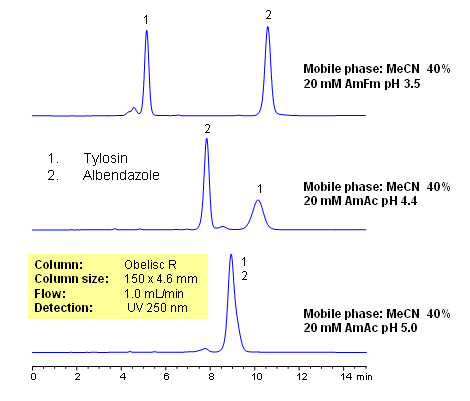
Tylosine is an antibiotic used in veterinary medicine. This sugar-based amino compound is found naturally in fermentation products. Presence of sugar moieties and amino group make it impossible to analyze this compound by reversed-phase HPLC with LC/MS compatible conditions. Mixed-mode chromatography allows to overcome this obstacle, and retain and analyze this and other aminoglycosides on an Obelisc R column. This column is suitable for analysis of aminosugars with several basic groups in the molecule (streptomycine, neomycin, amikasin, arbekasin, dibekasin, framycetin, kanamycin, gentamycin, verdomycin, astromycin, hydromycin, etc.). In case of several amino groups, higher buffer concentration and lower pH (3-3.5) are required in order to facilitate elution from the column. This method does not use ion-pairing reagent, and is designed to replace traditional reversed-phase columns and ion-pairing reagent methods. In this application, Albedazole is used as internal standard to quantify aminoglycoside.
Application Column
Obelisc R
SIELC has developed the Obelisc™ columns, which are mixed-mode and utilize Liquid Separation Cell technology (LiSC™). These cost-effective columns are the first of their kind to be commercially available and can replace multiple HPLC columns, including reversed-phase (RP), AQ-type reversed-phase, polar-embedded group RP columns, normal-phase, cation-exchange, anion-exchange, ion-exclusion, and HILIC (Hydrophilic Interaction Liquid Chromatography) columns. By controlling just three orthogonal method parameters - buffer concentration, buffer pH, and organic modifier concentration - users can adjust the column properties with pinpoint precision to separate complex mixtures.
Select optionsTylosin

